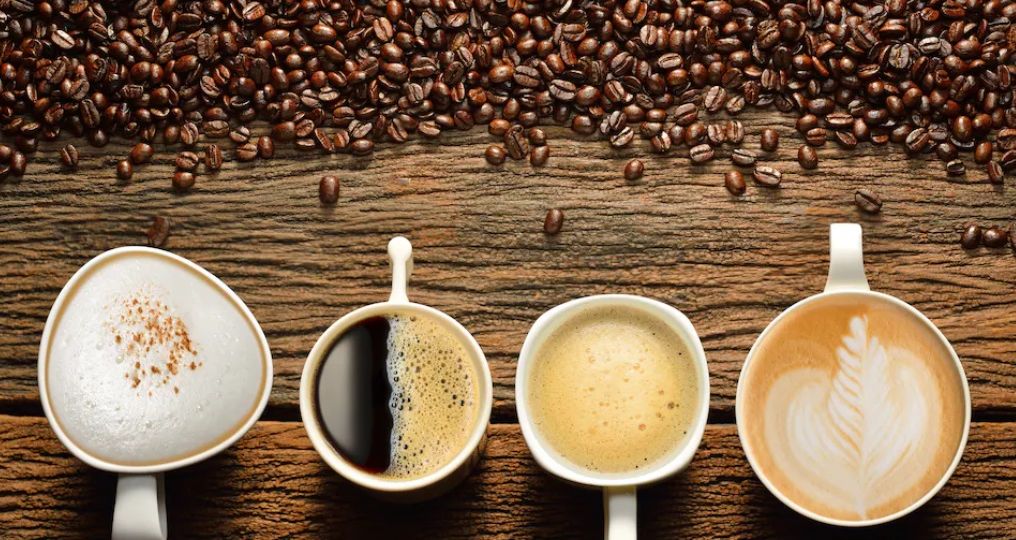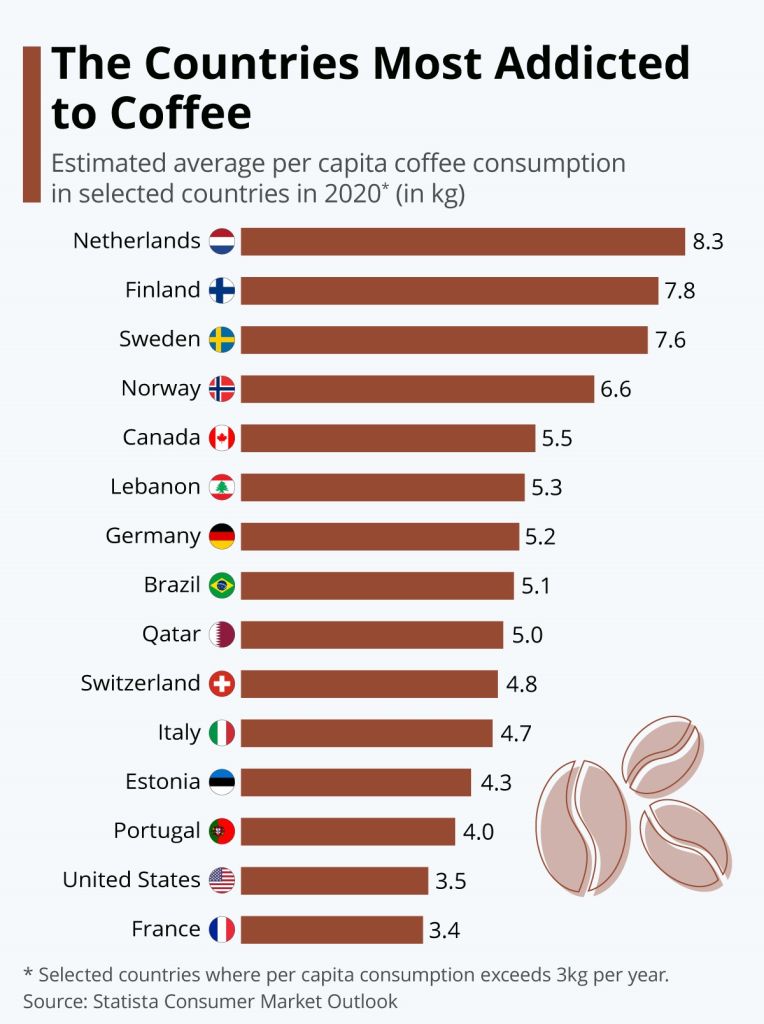
When it comes to global coffee consumption, there’s a rich tapestry of trends and traditions that varies dramatically from one country to another. What country drinks the most coffee per capita? This isn’t just a trivial fact; it reveals a lot about cultural habits and the role coffee plays in different societies. From the dark, rich espresso in Italy to the light and spiced versions in the Middle East, coffee is a global beverage that transcends borders, yet is deeply rooted in local customs.
Key Takeaways
- Trends in coffee consumption in top countries: Finland leads the world in coffee consumption per capita, with its residents consuming around 26 pounds of coffee per person each year. Neighboring Scandinavian countries also rank highly, illustrating a robust coffee culture where coffee is more than just a morning ritual.
- Cultural significance of coffee in these countries: In many of these top coffee-consuming nations, coffee is a significant part of daily life. For instance, in Sweden, the concept of ‘Fika’—a coffee break that includes a moment of pause—is central to everyday life, reflecting the importance of balance and social interaction.
- Differences in coffee consumption patterns: While Nordic countries often favor plain, black coffee, Southern European nations like Italy and Spain typically enjoy their coffee as an espresso, often as a social activity in cafés and public squares.

Which Country Drinks the Most Coffee Per Capita?
Finland tops the chart as the country that drinks the most coffee per capita. On average, each Finn consumes about 26 pounds of coffee annually. This figure is remarkably high, especially when compared to global standards, where such volumes of coffee per person are rare. The Finns’ love for coffee permeates every part of their daily life, from morning rituals to office breaks, underscoring a national affinity for this caffeinated beverage.
Cultural Significance of Coffee in Top Consuming Countries
In Finland, Norway, and Iceland, coffee is much more than just a drink; it’s a vital part of the cultural fabric. In these countries, coffee times are not just breaks but are woven into the day as significant social rituals.
- Finland: Here, coffee time, known as ‘kahvi’, is a cherished ritual. Many Finns indulge in several cups of coffee throughout the day, with a particular emphasis on enjoying coffee breaks at work, which are sometimes even mandated by labor unions.
- Norway: Similar to its neighbor Finland, Norway sees high coffee consumption, with the average person drinking about 22 pounds of coffee annually. Coffee in Norway often accompanies a sweet treat and is a central feature in social gatherings and business meetings.
- Iceland: While not as high on the list as Finland or Norway, Iceland still has a strong coffee culture. The average Icelander drinks numerous cups per day, enjoying coffee as a warm companion in the often cold climate. Cafes are popular spots, serving as hubs for social interaction and relaxation.
Coffee Consumption Trends in Europe and Beyond
Coffee culture varies widely across Scandinavia, broader Europe, and North America, reflecting diverse historical influences, climatic conditions, and social norms.
Scandinavia: In countries like Finland, Sweden, and Norway, coffee consumption is among the highest in the world. The coffee is typically served black and is consumed several times throughout the day. It’s common in these countries to enjoy coffee breaks that are socially ingrained as part of the work culture, famously known as ‘fika’ in Sweden, where it is accompanied by pastries or sandwiches.
Southern Europe: Moving to Southern Europe, coffee styles become markedly different. In Italy, espresso reigns supreme, often consumed quickly at the bar, standing up, and without any sugar. Spaniards enjoy their café con leche, a strong espresso mixed with hot, frothy milk, typically enjoyed leisurely. Similarly, in Greece, the traditional ‘Greek coffee’ is a strong brew served with the grounds, enjoyed slowly over conversations.
Western Europe: In France, the café culture is iconic, with small espressos served at all times of the day, and café au lait (coffee with milk) often enjoyed during breakfast. Meanwhile, in the Netherlands, coffee is typically served black, sometimes with a single cookie, and is a staple in almost every home and office.
United Kingdom: The UK might be famous for its tea, but coffee culture has been growing, with a strong preference for lattes, cappuccinos, and increasingly, artisanal coffee from independent coffeehouses.
North America: In the United States and Canada, coffee consumption is robust with a strong inclination towards drip and specialty coffee. The U.S. has seen a surge in third-wave coffee shops, focusing on the quality of the bean and artisanal brewing methods. Meanwhile, Canada’s coffee culture includes popular chains like Tim Hortons and a growing interest in sustainable and ethically sourced coffees.
The Role of Coffee in Social and Work Environments
In Scandinavia, coffee is not just a drink; it’s a pivotal part of the social fabric, especially in the workplace. In Finland, the coffee break is so ingrained that it’s almost a ritual, seen as essential for both productivity and camaraderie. Workplaces often mandate coffee breaks, providing employees with a dedicated time to relax and bond over coffee.
Sweden’s ‘fika’ is perhaps the most famous coffee-related social practice, symbolizing much more than a coffee break. It involves sitting down with colleagues or friends and enjoying coffee with a sweet treat, facilitating conversation and strengthening social bonds. This tradition underscores the Swedish emphasis on balance between work and leisure, and the importance of interpersonal connections.
FAQs
What country consumes the most coffee per person? Finland leads the world in coffee consumption per capita, with each person consuming an impressive average of 26 pounds of coffee annually.
How does coffee consumption vary across different countries? Coffee consumption patterns vary widely. Scandinavians typically enjoy plain black coffee, Southern Europeans prefer espresso-based drinks, and in North America, a wide variety of brewing methods and flavors are popular.
What are some unique coffee traditions around the world? From Italy’s quick espresso shots at the bar to Ethiopia’s ceremonial coffee preparation involving roasting, grinding, and brewing in a single ceremony, coffee traditions reflect the diverse cultures of the countries.
Final Thoughts
This exploration of global coffee consumption reveals not just the high volumes consumed, especially in Finland, but also the deep cultural significance coffee holds worldwide. Whether it’s fostering social connections or enhancing workplace productivity, coffee’s role is multifaceted and deeply embedded in various cultural traditions.









